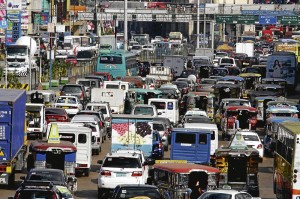
The Philippine government needs to invest some P2.3 trillion—or roughly $57.3 billion—from 2014 to 2030, to improve and overhaul the transport infrastructure in Metro Manila and its surrounding regions, according to the Japan International Cooperation Agency. INQUIRER FILE PHOTO
MANILA, Philippines—The Philippine government needs to invest some P2.3 trillion—or roughly $57.3 billion—from 2014 to 2030, to improve and overhaul the transport infrastructure in Metro Manila and its surrounding regions, according to the Japan International Cooperation Agency (Jica).
This proposed investment, which will be presented in the form of a road map to Malacañang this Thursday, is deemed crucial in averting further significant economic, labor, social and environmental losses brought about by the current traffic congestion in Metro Manila.
As it is, the Philippines is estimated to be losing some P2.4 billion in potential income per day due to the traffic jams that consume time that could be used for productive pursuits.
In a presentation before members of the Management Association of the Philippines on Tuesday, Jica project manager Shizuo Iwata said the proposed three-phase “Dream Plan” which covered Metro Manila, Region III (Central Luzon) and Region IV-A (Calabarzon) was necessary to be implemented since the covered areas account for 62 percent of the national GDP and 37 percent of the total population.
More notably, the completion of the Dream Plan is seen to yield significant economic savings of P1.2 trillion a year starting 2030; public transport fare savings of P18 per person per day; travel time reduction by 49 minutes per person per trip; and additional toll and fare revenues of P119 billion annually.
The plan will also impact positively on the environment, according to Iwata, as this proposal will reduce greenhouse gas emission by 10,233 tons per day.
Iwata further noted that the proposed Dream Plan will see the transport infrastructure as a “catalyst” that will “integrate cities, growth centers, gateways, urban and rural areas within a region; facilitate local economic development; enhance social integrity and promote environmental sustainability; and facilitate planned or guided urban growth and expansion of Metro Manila.”
In his presentation, Iwata said the transport road map would have five main components, namely, urban roads (missing links for C3, C5, bridges; 137 kilometers of new roads; flyovers, sidewalks and pedestrian facilities; secondary roads in peri-urban areas); expressways (426 km of intercity and 78 km of urban expressways); and urban or suburban rails (246 km of main lines; 72 km of secondary lines; integrated lines and improved accessibility).
Also included in the Dream Plan are buses and jeepneys (modern fleet and operation; rationalized route structure; improved terminals and interchange facilities); and traffic management (traffic signals, safety, enforcement and education).
Specific projects will include the connector road for the North Luzon Expressway and South Luzon Expressway and the North-South Commuter Rail and Edsa Subway.


